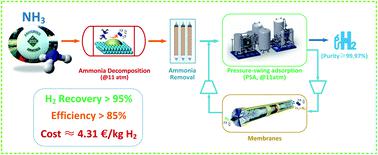当前位置:
X-MOL 学术
›
Sustain. Energy Fuels
›
论文详情
Our official English website, www.x-mol.net, welcomes your
feedback! (Note: you will need to create a separate account there.)
Techno-economic analysis and comprehensive optimization of an on-site hydrogen refuelling station system using ammonia: hybrid hydrogen purification with both high H2 purity and high recovery
Sustainable Energy & Fuels ( IF 5.0 ) Pub Date : 2020-04-08 , DOI: 10.1039/c9se01111k Li Lin 1, 2, 3, 4 , Yao Tian 1, 2, 3, 4 , Wenbin Su 1, 2, 3, 4 , Yu Luo 1, 2, 3, 4 , Chongqi Chen 1, 2, 3, 4 , Lilong Jiang 1, 2, 3, 4
Sustainable Energy & Fuels ( IF 5.0 ) Pub Date : 2020-04-08 , DOI: 10.1039/c9se01111k Li Lin 1, 2, 3, 4 , Yao Tian 1, 2, 3, 4 , Wenbin Su 1, 2, 3, 4 , Yu Luo 1, 2, 3, 4 , Chongqi Chen 1, 2, 3, 4 , Lilong Jiang 1, 2, 3, 4
Affiliation

|
Ammonia (NH3) has been considered to be a promising hydrogen storage medium owing to the carbon-free features, easy liquefaction storage, low transportation costs, and potential ammonia production from renewable energy sources. On-site hydrogen production using ammonia decomposition offers a sustainable and cost-efficient solution for hydrogen refuelling stations, and separating H2 from a H2–N2 mixture is a necessary step to obtain high-purity H2 (>99.97%). In the scale of a hydrogen refuelling station (∼300 Nm3 h−1), using pressure-swing adsorption (PSA) is not feasible owing to its low recovery, while using polymeric membranes cannot meet the H2 purity demand. To achieve both a high H2 purity and high H2 recovery, we developed a physical-chemical system model of a 300 Nm3 h−1on-site NH3-fed hydrogen refuelling station to optimize a H2 purification subsystem, and furthermore predicted the system efficiency and economic feasibility. We validated our system model using experimental data, and compared eight different scenarios of H2 purification subsystems. The results reveal that a NH3-fed on-site hydrogen refuelling station using a “PSA-to-membrane” subsystem is a feasible method of producing high-purity H2 with a H2 recovery greater than 95%, which is 29% higher than a system only using PSA. Correspondingly, the system efficiency increased from 59.1% to 85.37%, and the total specific cost was reduced by 22% to 4.31 € per kg. The feedstock cost accounts for 74% of the total specific cost. Using our optimized hybrid H2 purification subsystem, the H2 production cost of the NH3-fed on-site hydrogen refuelling station was at least 15% lower than other carbon-free routes (such as electrolysis, solar thermolysis, photo-electrolysis, etc.), and comparable to that of a methane steam reforming system with carbon capture and storage.
中文翻译:

使用氨的现场加氢站系统的技术经济分析和综合优化:高氢气纯度和高回收率的混合氢气纯化
由于无碳特性,易于液化存储,较低的运输成本以及潜在的可再生能源生产氨气,氨气(NH 3)被认为是一种有前途的氢气存储介质。利用氨分解的现场制氢技术为制氢站提供了一种可持续且具有成本效益的解决方案,从H 2 -N 2混合物中分离H 2是获得高纯度H 2(> 99.97%)的必要步骤。在加氢站的规模内(〜300 Nm 3 h -1),由于其回收率低,使用变压吸附(PSA)是不可行的,而使用聚合物膜不能满足H 2纯度要求。为了实现高H 2纯度和高H 2回收率,我们开发了一个300 Nm 3 h -1的现场NH 3进料氢气加氢站的物理化学系统模型,以优化H 2净化子系统,此外,预测系统效率和经济可行性。我们使用实验数据验证了我们的系统模型,并比较了H 2净化子系统的八种不同情况。结果表明,一NH 3 -喂食使用“ PSA到膜”子系统的现场加氢站是生产H 2回收率大于95%的高纯度H 2的可行方法,比仅使用PSA的系统高29%。相应地,系统效率从59.1%提高到85.37%,总单位成本降低了22%,降至每公斤4.31€。原料成本占总特定成本的74%。使用我们优化的混合H 2净化子系统,由NH 3供给的现场加氢站的H 2生产成本比其他无碳路线(例如电解,太阳能热解,光电解,等等),并且与具有碳捕集和封存功能的甲烷蒸汽重整系统相当。
更新日期:2020-04-08
中文翻译:

使用氨的现场加氢站系统的技术经济分析和综合优化:高氢气纯度和高回收率的混合氢气纯化
由于无碳特性,易于液化存储,较低的运输成本以及潜在的可再生能源生产氨气,氨气(NH 3)被认为是一种有前途的氢气存储介质。利用氨分解的现场制氢技术为制氢站提供了一种可持续且具有成本效益的解决方案,从H 2 -N 2混合物中分离H 2是获得高纯度H 2(> 99.97%)的必要步骤。在加氢站的规模内(〜300 Nm 3 h -1),由于其回收率低,使用变压吸附(PSA)是不可行的,而使用聚合物膜不能满足H 2纯度要求。为了实现高H 2纯度和高H 2回收率,我们开发了一个300 Nm 3 h -1的现场NH 3进料氢气加氢站的物理化学系统模型,以优化H 2净化子系统,此外,预测系统效率和经济可行性。我们使用实验数据验证了我们的系统模型,并比较了H 2净化子系统的八种不同情况。结果表明,一NH 3 -喂食使用“ PSA到膜”子系统的现场加氢站是生产H 2回收率大于95%的高纯度H 2的可行方法,比仅使用PSA的系统高29%。相应地,系统效率从59.1%提高到85.37%,总单位成本降低了22%,降至每公斤4.31€。原料成本占总特定成本的74%。使用我们优化的混合H 2净化子系统,由NH 3供给的现场加氢站的H 2生产成本比其他无碳路线(例如电解,太阳能热解,光电解,等等),并且与具有碳捕集和封存功能的甲烷蒸汽重整系统相当。











































 京公网安备 11010802027423号
京公网安备 11010802027423号